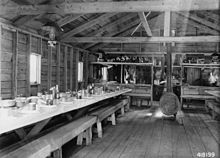Logging camp
A logging camp (or lumber camp) is a transitory work site used in the logging industry. Before the second half of the 20th century, these camps were the primary place where
Design
The requirements of the logging industry involved the creation of a working site and housing from the
Primitive sites had two buildings, a
In the United States, logging camps were phased out after World War II, as work crews could more easily be transported to remote logging sites.[5]
Camp food

Lumberjacks could work upwards of twelve hours a day, and lumbering was such physically demanding work that each man could eat between 6,000 to 9,000
In Canada, the long distances to the camps and the closure of most access during the winter led to the development of depot farms that would be built near logging camps to supply cereals and vegetables to the loggers as well as food for horses in the form of hay and oats. These farms were often built on poor quality land and had little output other than the camps and self-consumption, and most often closed as soon as the camp did.[8]
See also
References
- JSTOR 41331174.(subscription required)
- ^ a b c "Logging Camps: The Early Years". Minnesota DNR.
- S2CID 131635434.(subscription required)
- ^ Woodward, George Austin (September 1894). "Life in a Lumber Camp". Munsey's Magazine. pp. 604–610 – via Explorations in Iowa History Project.
- JSTOR 3113615.(subscription required)
- S2CID 156435149.
- ^ a b c "Camp Food in a Logging Camp". Mendocino Coast Model Railroad and Navigation Company.
- ^ MacKay, Roderick (2007). Potatoes in the Pines: Depot Farms in Algonquin Park; with particular investigations at the Egan Farm, BkGl-1, Clancy Township (Technical report). Proceedings of the 2005 Ontario Archaeological Society Symposium.
External links
- "Logging camp". Forest History Center. Minnesota Historical Society.
